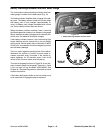
Workman e2050/e2065
Page 3 – 20
Electrical System (Rev. B)
Main and Accessories Contactors
Two contactors (solenoids) are used on the Workman
e2050 and e2065 for circuit control.
The main contactor provides current to the vehicle con-
troller and is energized when the on/off switch is ON.
The main contactor is located under the controller cover
beneath the bed (Fig. 31).
The accessories contactor provides current to the head-
lights, horn and optional electrical accessories. The ac-
cessories contactor is energized when the on/off switch
is ON. The accessories contactor is located beneath the
dash panel.
Testing
NOTE: Prior to taking small resistance readings with a
digital multimeter, short the meter test leads together.
The meter will display a small resistance value (usually
0.5 ohms or less) that is due to the internal resistance of
the meter and test leads. Subtract this value from the
measured value of the component you are testing.
1. Make sure on/off switch is turned OFF. Open the bat-
tery circuit by removing one of the battery cables (see
Opening Battery Circuit in the General Information sec-
tion of this chapter and Fig. 32).
2. Locate contactor that is to be tested. Disconnect all
vehicle harness electrical connections from contactor.
Note wire connector locations on contactor for reas-
sembly purposes.
3. Using jumper wires, apply 48 VDC directly across the
contactor coil posts (Fig. 33). The contactor should click.
With the contactor coil energized, resistance across the
main contact posts should be less than 1 ohm.
4. Remove voltage from contactor coil posts. The con-
tactor should click. With the contactor coil not energized,
resistance across the main contact posts should be infi-
nite ohms.
5. Measure resistance across the contactor coil posts
(Fig. 33):
A. For the main contactor, the resistance should be
approximately 126 ohms.
B. For the accessories contactor, the resistance
should be approximately 200 ohms.
1. Main contactor
2. Cable to controller B+
3. Wire harness connector
4. Fuse (F1)
5. Positive battery cable
6. Isolator
Figure 31
3
2
4
1
5
6
1. Negative cable to vehicle 2. Positive cable to vehicle
Figure 32
A
4
1
2
Figure 33
1. Main contactor
2. Accessories contactor
3. Main contact posts
4. Contactor coil posts
4
3
3
4
4
4
3
3
2
1


















